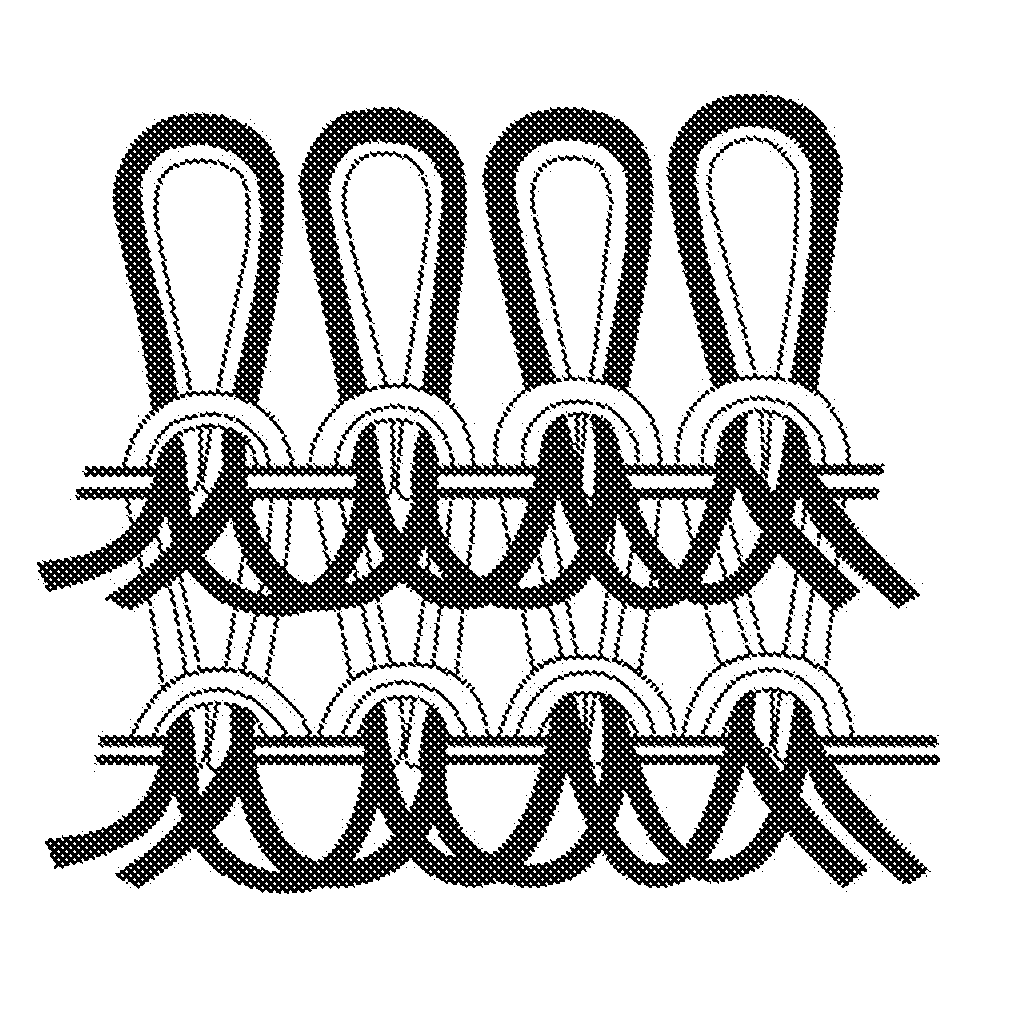High hygroscopic wound dressing and preparation method and use thereof
a high-hygroscopic, wound technology, applied in the direction of bandages, machines/engines, transportation and packaging, etc., can solve the problems of thread sticking to the wound, low strength of the dressing, infection of the surrounding healthy skin, etc., to achieve good absorption and fluid retention properties, high absorbency of gelling fibres, and no significant weakened wet strength
- Summary
- Abstract
- Description
- Claims
- Application Information
AI Technical Summary
Benefits of technology
Problems solved by technology
Method used
Image
Examples
example 2
[0041]Feed 2×167 dtex polyester filaments into the WHCW-S18C-27A-1176 circular knitting machine. The needle gauge is 14 needles / inch, the backing layer density is 20 / inch.
[0042]Feed the calcium / sodium alginate slivers (linear density 6.7 g / m) into the above knitting machine. The fiber linear density is 2.65 dtex and the number of slivers is 9.
[0043]The blow method: back.
[0044]The fabric obtained has the weight of 320 g / m2.
[0045]The length of free fiber of the fluffy layer is 12 mm. The absorbency measured by EN 13726-1:2002 / AC:2003 is 32 g / 100 cm2.
[0046]The fabric dry strength in CD is 109 N / cm, Elongation 128%. The fabric wet strength 100 N / cm, elongation 115%. The fabric dry strength in CD is 44 N / cm,
[0047]Elongation 192%. The fabric wet strength 41 N / cm, elongation 168%.
example 3
[0048]Feed 2×167 dtex polyester filaments into the WHCW-S18C-27A-1176 circular knitting machine. The needle gauge is 14 needles / inch, the backing layer density is 20 / inch.
[0049]Feed the carboxymethyl cellulose fiber sliver (linear density 6 g / m) into the above knitting machine. The fiber linear density is 2.1 dtex and the number of slivers is 9.
[0050]The blow method: back.
[0051]The fabric obtained has the weight of 300 g / m2.
[0052]The length of free fiber of the fluffy layer is 8 mm. The absorbency measured by EN 13726-1:2002 / AC:2003 is 33 g / 100 cm2.
[0053]The fabric dry strength in CD is 105 N / cm, Elongation 120%. The fabric wet strength 95 N / cm, elongation 105%. The fabric dry strength in CD is 42 N / cm, Elongation 182%. The fabric wet strength 39 N / cm, elongation 165%.
example 4
[0054]Feed 2×167 dtex polyester filaments into the WHCW-S18C-27A-1176 circular knitting machine. The needle gauge is 14 needles / inch, the backing layer density is 20 / inch.
[0055]Feed ancylated chitosan slivers (linear density 6 g / m) into the above knitting machine. The fiber linear density is 2.2 dtex and the number of slivers is 9.
[0056]The blow method: back.
[0057]The fabric obtained has the weight of 290 g / m2.
[0058]The length of free fiber of the fluffy layer is 5 mm. The absorbency measured by EN 13726-1:2002 / AC:2003 is 32 g / 100 cm2.
[0059]The fabric dry strength in CD is 101 N / cm, Elongation 128%. The fabric wet strength 92 N / cm, elongation 112%. The fabric dry strength in CD is 39 N / cm, Elongation 180%. The fabric wet strength 40 N / cm, elongation 176%.
PUM
| Property | Measurement | Unit |
|---|---|---|
| Length | aaaaa | aaaaa |
| Length | aaaaa | aaaaa |
| Length | aaaaa | aaaaa |
Abstract
Description
Claims
Application Information
 Login to View More
Login to View More - R&D
- Intellectual Property
- Life Sciences
- Materials
- Tech Scout
- Unparalleled Data Quality
- Higher Quality Content
- 60% Fewer Hallucinations
Browse by: Latest US Patents, China's latest patents, Technical Efficacy Thesaurus, Application Domain, Technology Topic, Popular Technical Reports.
© 2025 PatSnap. All rights reserved.Legal|Privacy policy|Modern Slavery Act Transparency Statement|Sitemap|About US| Contact US: help@patsnap.com


